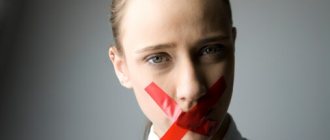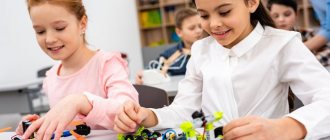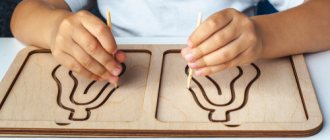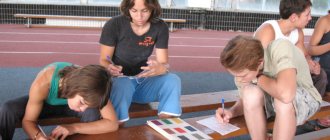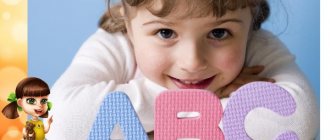Alalia is the name given to underdevelopment or complete absence of speech in children. This is the result of damage to the central nervous system that occurred either in fetal development or in the first 3 years of the child’s life. If the necessary measures are not taken in time, a child with such a disease will never learn to talk.
Alalia is in no way associated with intellectual or hearing impairments of the child. There are cases when patients with this disease began to talk only after reaching school age.
Please note: Alalia is a disease that cannot be treated independently. To find out an accurate diagnosis and receive subsequent treatment, you need to contact a neurologist who will examine the child.
The appearance of secondary speech delay occurs if treatment for alalia was started at a later age of the patient. Children with this disease demonstrate a poorer knowledge of the world around them than their peers. Alalia is accompanied by violations of lexical, phonetic, syntactic, morphological and grammatical speech.
Sensory alalia
This is a developmental defect in which the patient does not speak himself. He is also unable to understand the words that are addressed to him. Among children who suffer from problems associated with the speech apparatus, sensory alalia occurs only in 10% of cases.
With sensory alalia, the child does not understand the speech of others, and his speech does not develop. Speech impairment in this case is secondary in nature, as it is associated with problems related to misunderstanding of the speech of others and impaired phonemic hearing.
This form of alalia is accompanied by underdevelopment or damage to the speech-hearing analyzer. As a result, the child is unable to connect sounds heard from adults into words.
What is alalia
Alalia in children is a consequence of damage that occurred during the prenatal or early period of life. Without specially developed treatment, children with this disease will not begin to speak independently.
The appearance of speech may be postponed to preschool, and in some cases to a later period. In such children, such speech delay is not associated with hearing and intellectual defects.
Attention! Alalia cannot be treated at home; to make a diagnosis and prescribe therapy, you only need to visit a specialist in person. First of all, you need to contact your local pediatrician, who will refer the child for further examination.
If correctional therapy begins after 4-5 years, secondary speech delay is possible, associated with the mental development of the child. These children have less knowledge about the world around them than their healthy peers. Alalia is characterized by violations of all aspects of speech:
- phonetic;
- lexical;
- grammatical;
- morphological;
- syntactic.
This is a systemic disorder of the speech apparatus, in which it is difficult to learn the rules of functioning of the native language. The vocabulary is poor and ungrammatical. The treatment is complex and systematic over several years. Statistically, boys suffer from it twice as often.
Alalia is a persistent, severe pathology of the speech apparatus. Children with this diagnosis have difficulty acquiring language. They do not perceive speech as a single system. There are cases when a child does not begin to speak even by school age.
Disorders associated with this disease affect the baby's speech and cognitive activity. Later, problems may arise during the formation of personality. There is often a lack of desire for development and interaction with the outside world.
Alalia is characterized by a systemic nature of speech development disorders, which affects all its components. A child with such impairments does not understand speech addressed to him; all communication is reduced to short babbling words.
In subsequent years, a poor vocabulary, agrammatism, incorrect construction of syllables, and disturbances in the pronunciation of sounds are observed. Alalia is one of the most severe speech disorders. It is impossible to solve this complex problem without the help of speech therapists and other specialists.
Causes
The reason for the appearance of sensory alalia in a child is damage to certain areas of the brain that are located in the cortical part. These zones are responsible for the speech apparatus, understanding and analysis of audible sounds. The following factors can lead to such a violation:
- Diseases that arise in the first years of a child’s life.
- Central nervous system disorders that arose during complicated childbirth.
- Fetal pathologies that appeared during pregnancy.
A speech disorder such as sensory alalia can also be caused by other reasons. Diagnosis of the disease is possible only after a complete examination of the baby by specialists such as a neurologist, speech therapist and psychologist.
Causes of alalia
Different factors contribute to the occurrence of speech disorders at different stages of life. So, in the antenatal period:
- fetal hypoxia;
- toxicosis;
- injury to the fetus due to falls or bruises of the mother;
- intrauterine infections and inflammations;
- threats of miscarriage;
- metabolic disorders during intrauterine development;
- maternal diseases of a chronic nature (heart and pulmonary failure, hypertension, etc.).
In the perinatal period:
- difficult or pathological childbirth;
- asphyxia, hypoxia of the newborn and intracranial birth injury;
- use of obstetric devices.
In the first years of life:
- brain injuries;
- inflammatory processes of the brain;
- diseases that cause depletion of the nervous system;
- frequent or prolonged somatic diseases.
In addition to biological factors, the condition is aggravated by unfavorable social conditions of the child’s development: pedagogical neglect, lack of verbal contact or its rarity. As a rule, with alalia there is not one reason that provokes an increase in the defect, but a whole complex that leads to brain dysfunction.
Symptoms
With a form of disorder such as sensory alalia, the child is unable to understand speech that was addressed to him. If the disorder is severe, then the child may experience absolute indifference to any sounds, regardless of the nature of their origin. The patient does not respond to his name and cannot distinguish the speech of an adult from any other sounds in space. If the form of the disorder is mild, then the child can demonstrate understanding of individual words from everyday life.
With sensory alalia, the child’s speech activity is quite high, but he utters only simple sounds, the meaning of which cannot be understood by others. The child is not able to repeat words after adults, and he also cannot compare objects and words.
A distinctive feature of this type of alalia is the repeated repetition of any sounds without understanding the meaning of what was said.
Alalia classification
Modern speech therapy distinguishes two forms in the classification of alalia - expressive (motor) and impressive (sensory). There is alalia that combines these two forms - sensorimotor (mixed type).
Expressive or motor – systemic underdevelopment of expressive speech of a central organic nature. This is due to the insufficient development of language operations.
Impressive or sensory alalia is a speech disorder that has a central pathogenesis. A child with this diagnosis is unable to understand speech addressed to him due to the malfunction of the speech-hearing analyzer.
Each of these types has its own treatment method. Without proper therapy, the sensory type is more dangerous for a child's development than the motor type. Based on neurophysiology, neurochemistry and psycholinguistics, methods for correcting all types of alalia have been developed. But the child’s parents must prepare themselves for long and hard work.
To make it easier to monitor speech development, speech therapists recommend a convenient and simple diary, where you should write down all the baby’s new words. You can download this questionnaire, fill it out and continue further. Be sure to take it with you to your appointment with a specialist - with its help you can quickly form a general impression of your child’s speech skills
Correction methods
Sensory alalia can be corrected only with an integrated approach, which includes:
- taking the necessary medications prescribed by a neurologist;
- neuropsychological correction;
- classes with a speech therapist-defectologist;
- conducting audiotherapy according to the A. Tomatis method (as prescribed by a neurologist);
It is important that the assistance is comprehensive, therefore, in addition to taking medications that have a positive effect on the central nervous system, a specialist may prescribe comprehensive neurological rehabilitation.
Prognosis and prevention
The result depends on the type of motor alalia, the severity, and the age at which the disease was diagnosed and therapy was started. If all these conditions are met and adequate treatment is provided, the prognosis is favorable. Children catch up with their peers in speech and general development, acquire communication skills and even study in a regular school.
Severe motor alalia is difficult to correct, especially if it is diagnosed late. But with due persistence and following the doctor’s recommendations regarding treatment, it is possible to achieve significant progress.
Prevention of motor alalia begins during pregnancy planning. The expectant mother needs to eliminate bad habits, adjust her diet and daily routine. It is necessary to approach childbirth adequately and prevent injuries. It is also important to create favorable conditions for the development of the child in the postpartum period and subsequently, to devote time to developmental activities.
And of course, it is necessary to consult a doctor at the first signs of deviations in speech development in order to undergo a timely diagnosis and identify the cause.
Forecast, preventive measures
When alalia is detected in a child, it is important to start therapy as early as possible. This will not only significantly smooth out existing speech disorders, but also reduce the risk of developing deviations in the future. Only the attending physician can give a prognosis, since this is very individual and depends on many factors: the severity of the disease, the degree of neglect, the presence of associated complications, and the individual characteristics of the child’s body.
The chance that a child will be able to acquire formed, full-fledged speech with sensory alalia is significantly reduced when contacting a specialist late. Lack of therapy can aggravate the situation and cause poor socialization of the child in the future.
It is appropriate to take measures to prevent sensory alalia not only during pregnancy, but also in the first few years of a child’s life.
Article:
Currently, there has been significant progress in the development of speech therapy.
Based on psychological analysis, important data were obtained on the mechanisms of the most complex forms of speech pathology (aphasia, alalia, general speech underdevelopment, dysarthria). Alalia is one of the severe and persistent forms of speech pathology. Many children with alalia do not acquire language and remain non-speaking or barely speaking even after entering school. Thus, the problem of diagnosing and organizing correctional and educational work for alalia is one of the most important and fundamental scientific and pedagogical problems of the system of preschool and school educational institutions at the present time. A characteristic or complex symptom complex of linguistic and non-linguistic disorders has a negative impact not only on speech communication, but to a certain extent also on the development of cognitive activity of certain aspects of the personality, and often prevents the achievement of needs and aspirations that are significant for the developing personality.
Thus, all these factors indicate that the teacher, defectologist and speech therapist need comprehensive and deep knowledge about this form of pathology of speech activity in order to be able to analyze the nature of the pathology in future practical work and find optimal ways to overcome it.
This problem is solved mainly through the creation of tests, diagnostic methods, various systems of correctional and speech therapy for both motor and sensory alalia, through the organization of specialized kindergartens and schools, the purpose of which is the early education and upbringing of children with this speech pathology .
At the same time, there are many unresolved issues in the theoretical development of the problem of alalia. All this creates the urgency of this problem.
Many studies in the historical past are devoted to this aspect of the work. Thus, in 1888, a detailed correction of “idiopathic alalia” was presented by R. Cohen. He expressed a judgment about its etiology, the nature of damage to the speech apparatus, the mechanism, symptoms, differential diagnosis and methods of speech education in these children. Alalia/muteness/ was first identified as a separate speech disorder in 1830 by R. Schulthess and was considered by him in connection with articulation disorders.
Significant contributions to the study of alalia were made by G. Gutman, A. Liebmann, M.V. Bogdanov-Berezovsky, R.A. Belova - David, E. Fretels, and at a later time M.E. Khvattsev, V.K. Orfinskaya, R. E. Levina, E. R. Sobotovich, V. I. Kovtikov, V. K. Vorobyova, L. S. Volkova and other researchers.
The work of various authors has identified the features of speech development and the structure of the defect in alalia based on the use of various criteria: physiological, clinical, psychological, linguistic and others. Various forms of alalia have been described, and a method of speech therapy intervention has been developed for various forms of speech underdevelopment. Thus, V.K. Orfinskaya in her book “Development of Thinking and Speech in Abnormal Children” offers differentiated methods that correspond to the characteristics of the forms of alalia she identified. She also tried to theoretically substantiate this problem and show in practice how to implement it.
N. S. Zhukova, E. M. Mastyukova, T. B. Filicheva, B. M. Grinshput, E. F. Sobotovich, and other representatives of the “language” concept highlight the main task of speech therapy - educating children’s ideas about the patterns of functioning language system, about the interaction of its components. They distinguish a number of psychological and individual characteristics that must be taken into account when working with children.
Thus, successes in the study of alalia in the works of the most recent period have been achieved due to the fact that researchers in their activities began to widely rely on the methodology of an integrated approach to the analysis of the defect. And unlike previous periods, when, according to V.K. Orfinskaya, there were more controversial issues and arguments between alalia researchers than generally accepted positions, at the present stage of development of speech therapy there is more in common than disagreement. The general is manifested in the basic principles of understanding the defect, its mechanism, and ways to overcome it.
But despite all the existing developments in the theory and practice of correctional educational training for children with alalia, such fundamental issues as the problems of sensory alalia have not yet received a proper solution, since this problem has caused heated discussions throughout the history of its study. Sensory alalia is less studied than motor alalia. The existence of sensory alalia as an independent disorder even now raises doubts among some researchers; sometimes it is believed that the diagnosis is made without the necessary grounds. The mechanism and symptoms of alalia have not been sufficiently studied. There are also a number of difficulties and shortcomings in the practice of schools and preschool institutions. They boil down to the following:
— weak material base of institutions;
- insufficient methodological and speech therapy training for teachers and educators;
- an insufficiently thought-out system of work for teachers, educators and speech therapists in this area.
— lack of methodological literature.
— there is no continuity between the preschool institution and the primary level of education.
Based on the above, we can formulate the problem of this work. The problem is to identify and consider under what psychological and pedagogical conditions speech therapy intervention is most effectively carried out on children with alalia. What methods, means and forms are most appropriate.
Practical significance.
This work, in our opinion, contains a certain practical significance. Methodological recommendations for parents, teachers and kindergarten workers, observation data show the advantage and all the positive aspects of the work of those educators, teachers and speech therapists whose classes are aimed not only at correcting the defect, but also mainly at the development of the child as a whole.
The work gives an idea of alalia, its forms, etymology, mechanism, symptoms and the choice of directions for speech therapy work.
Based on theoretical developments and research by many scientists, the current state of this problem is revealed and the main issues that will be considered and studied in the future are highlighted.
“The study of such a severe speech disorder as alalia is an extremely promising area and opens up the widest opportunities for researchers. It is no coincidence that the study of severe speech pathologies is attracting more and more researchers. Alalia is an organic disorder, underdevelopment of speech of a central nature - one of the most global problems of our time.” Kovtikov V.A., Elkonin Yu.A. — Mental and speech disorders in children. - L., 1979.
I. _ GENERAL CHARACTERISTICS OF ALALIA.
Any process or phenomenon that is directly studied or investigated has its own positive and most characteristic, typical features that distinguish this or that process or phenomenon from similar ones.
When defining alalia, based on the work of V.A. Kovshilov, we can proceed from the division of all speech disorders into 4 large groups, namely:
- to the group of automotor disorders /in which perception or articulation are primarily impaired/;
- to a group of psychological disorders /in which various components of the speech process are disorganized/;
- to a group of semantic / semantic / disorders / in which the semantic aspect of speech is disrupted /;
- into a group of language disorders / in which the structural and functional side of the language is disrupted - phonemic, grammatical and lexical operations in the process of speech damage /.
Taking into account this and other conditions, we can give the following definition of the pathology of speech activity that interests us.
Alalia is the absence or underdevelopment of speech due to organic damage to the speech areas of the cerebral cortex in the prenatal or early developmental period of the child.
There is an opinion that most children with alalia have (or had in the early stages of their development) often pronounced but multiple damage in both hemispheres of the brain.
The mechanism of alalia is poorly understood. There are different points of view in the study of alalia. Some researchers are disordered functioning. The language mechanism is associated with pathology of motor skills, others with pathology of certain aspects of mental activity, and still others with selective failure in mastering language as a unique sign system. But despite such discrepancies, representatives of different directions agree that the disorder of the language mechanism is based on organic failure of the brain.
During its development, alalia undergoes a number of quantitative and qualitative changes. Children, having mastered relatively simple units of language and the rules of their functioning, for a long time experience difficulties in mastering complex units and rules. Having mastered oral speech, they cannot fully master written speech for a long time.
When determining alalia, the necessary criteria are:
1. Delay in the rate of normal language acquisition.
- Pathological development of language.
3. The presence at certain stages of ontogenesis, to varying degrees of severity, of violations of all subsystems of language.
4. Preservation of hearing.
5. Satisfactory understanding of spoken speech for a certain age.
A very large number of different terms are used to refer to alalia, which reflects different ideas about it and insufficient knowledge of its etiology, mechanism and dynamics. The most common terms are “idiopathic alalia” /congenital/, “auditory muteness”, “developmental aphasia” and “constitutional delay”, “general speech underdevelopment”, “impaired language acquisition”, “language inability”. Examples of rarely used and uninformative terms: “muteness”, “non-speaking children”, “children with severe/profound/ speech impairments”. These terms have an uncertain meaning and many fundamentally different forms of speech disorders can be attributed to them.
Because. that many authors define the boundaries of alalia in different ways /i.e. They consider alalia to be a variety of variants of language development, but recently there is no convincing data on its spread. However, the available data are very limited and contradictory.
It was also found that alalia is more common in males, the frequency ratio between the sexes is 2:1.
According to clinical observations conducted by many researchers, it is noted that compared to impressive/sensory/expressive alalia, it is much more common.
The presented research results and experimental data prove the following basic judgments about alalia:
- Alalia is a systemic underdevelopment of speech, in which all components of speech are disrupted: phonetic-phonemic side, lexical-grammatical structure.
- For children with alalia, not only a delay in the development of the mechanism of expressive speech is typical, but mainly its pathological development.
- Violation of the mechanism of expressive speech is characterized by disorganization of all language systems and the language system as a whole.
II . CAUSES OF ALALIA.
Based on the data provided by L.S. Volkova and others in the textbook. manual "Speech therapy" for students of defectology. fak. ped. In-tov, we note that various authors have identified the causes of alalia. Thus, A. Libman (1901) associated speech deficiency in alalia with intellectual deficiency. A. Treitel considered alalia to be a consequence of a lack of attention and memory, M. Zeeman (1962) emphasized that speech does not develop due to disorders of the brain speech centers (cerebral speech zones). Many other scientists, including M. Beri (1957), M. Baidinova (1961), G. Luchsinger (1970), V.A. Kovtikov (1985) noted the leading role in the occurrence of alalia of natural traumatic brain injuries and asphyxia of newborns. Birth injuries and asphyxia can in some cases be the result of intrauterine pathology. This causes chronic oxygen starvation and leads to a decrease in the function of the respiratory center, which leads to disruption of associative connections that ensure the formation of higher cortical functions of a person, primarily speech and the psyche.
Among the etiological factors, there are also meningitis, intrauterine encephalitis, unfavorable developmental conditions, intrauterine or early acquired brain injuries, fetal intoxication, early childhood diseases with complications on the brain, etc.
Birth traumatic brain injuries and asphyxia of newborns cause local disorders, while intrauterine pathology leads to diffuse damage to the brain substance. Thus, any damage to various areas of the cerebral cortex leads to developmental disturbances in the functioning of speech and non-speech systems.
Various degrees of severity of alalia are observed: from relatively mild disorders, in which speech, although slowly distorted, develops independently from 3-4 years, to severe ones, when the child does not use speech even at 10-12 years. Later, with systematic help, he masters defective and poor speech.
In this paragraph, it is necessary to consider in more detail the reasons for alalia. As a result, it is necessary to note how causes as such are studied at individual stages of the communication process. Biological and social factors and their dialectical relationship are important in etiology.
So, social reasons are stimulation and speech pattern. The social environment stimulates speech development and provides a speech pattern, especially in the early stages. Stimulation is the effect on a child of appropriate speech stimuli /words/ in order to stimulate the reflex and imitate speech activity.
An incorrect speech pattern can also be a cause of speech underdevelopment (for example, imitation of incorrect pronunciation).
This is often combined with other causes of alalia.
In addition to social factors, dysfunctions of the analyzers, mainly visual and auditory, should be noted as possible causes. Violations of the visual analyzer can cause delayed speech development; this should be taken into account when training. However, the auditory analyzer plays a leading role in speech development.
Partial hearing loss - a greater or lesser deformation of perception - has a negative effect on the development of speech and psyche. Absence or early loss of hearing inhibits the reception of information. Spontaneous speech does not develop, it follows that the formation of mental functions that depend on the development of speech, which arise as a result of hearing impairment, is delayed, can be identified at an early age and belong to an independent group of disorders; they are not included in the concept of alalia.
When studying the etiology of alalia, it is necessary to consider the reasons located in the central, expressive part and in more detail the reasons for the social environment,
REASONS FOR THE CENTRAL PART:
Input /receipt of information/.
Input disturbances concern cognitive activity—recognition of perceived forms of speech. In sound-speech communication, cognitive activity is the recognition or identification of the structure of a sound-speech sign, which was previously perceived by ear and stored in memory. According to information theory, the verbal cognitive process can be considered as the decoding of speech sounds, where decoding refers to the recognition of a sign, but not yet the understanding of the content of words.
In oral speech, cognitive activity corresponds to I, expressed in the inability to recognize and remember word structures. If this disorder concerns the area of hearing, then we speak of auditory verbal agnosia /verbal deafness/, if it affects vision, then we speak of visual verbal agnosia /verbal blindness/. Speech cannot develop spontaneously, so the consequence of auditory verbal agnosia is delayed speech development. The functional integrating center connects the heard or seen and recognized sign with its content. Recognition of the content of information is the basis of the cognitive process with which the programming of speech activity is associated. The most complex components of the communication process are carried out in the integrating center.
REASONS FOR V E X P R E S S I V N A P H A T I
The process of speech realization is coordinated by motor systems. Disruption of the activity of these systems at an early age may be a consequence of perinatal encephalopathy. In its severe forms, paralysis of various types and degrees may occur.
Mild forms of perinatal encephalopathy due to minor diffuse changes in the motor systems manifest themselves either in motor lability or in insufficient motor development, sometimes in a combination of both. Motor underdevelopment or retardation makes it difficult to coordinate speech movements, which leads to delayed speech development with motor alalia.
The consequence of severe speech delay is alalia.
A special form with a possible violation of speech development is the relearning of left-handedness. Left-handed children, who were retrained to use their right hand at an early age, often experience developmental delays in some cases. If they are retrained in an inept way by force, then along with a delay and distortion of speech development, disorders may occur*
Causes of social environment - social feedback. The child's speech is directed to his environment. The reaction of others acts as feedback. It is important for the child whether his statement met with approval or refusal, whether it was accompanied by success or failure. Often this psychological moment, so important for the development of speech, is not given due importance. Negative social influence, when a child finds a satisfying response to his statements, inhibits speech development.
Growing up with high demands can lead to neurotic reactions, such as negativism, which negatively affects speech development. The child does not want to speak and speech development is delayed.
From the point of view of understanding alalia, the concept of “hearing muteness” found in old literature can be divided into certain components depending on the predominance of biological, social reasons or their combinations.
So, the reasons that cause alalia are diverse, and many studies by various scientists and the data presented in this chapter also confirm that speechlessness in children can be based on different etiologies.
Hence, the primary diagnosis of alalia is not confirmed in some cases, because The cause of speech underdevelopment may be hearing loss or severe intellectual disability. Only a comprehensive examination of such children with the participation of neurologists can reveal the true structure of the defect. Only studying the possible causes of speechlessness in children will allow specialists to choose the necessary effective forms of correctional and educational work.
Depending on the predominant localization of damage to the speech areas of the cerebral hemispheres, two forms of alalia are distinguished: motor and sensory.
Motor alalia
This form of disorder is a consequence of motor disorders in the child’s body. Accompanied by a poor vocabulary. A child with this type of alalia finds it difficult to express his thoughts, form phrases and use words correctly.
Children with motor alalia have normal mobility of the organs responsible for speech. However, it is difficult for a child, for example, to lift his tongue up if adults ask him to do so. He cannot repeat the words he heard. Such children have mental and neurological disorders due to the disease.
More often, children with motor alalia have difficulty in physical activity, but in some cases the child may demonstrate increased activity, which is associated with the location of the lesion in the brain.
Corrective work of a speech therapist
All corrective work must be carried out consistently and comprehensively. Treatment is carried out in several stages of a certain sequence.
Stage one
Training in distracting noises not related to speech. This may be the sound of a bell, rattles or other objects. Sounds must have different tonality, timbre, and volume.
Stage two
Teaching individual letters and sounds. The baby must learn to understand and pronounce simple sounds consisting of individual letters, for example, “rrrrrr”.
Stage three
Learning to pronounce syllables, simple words.
Stage four
Learn to pronounce words. There is training in composing simple word combinations and phrases.
Stage five
Increasing active and passive reserve, complication of speech patterns.
Possible mental disorders
Motor alalia is accompanied by various deviations that affect various areas of the child’s interaction with the outside world. A child with such a disorder reacts violently to everything, often cries and becomes hysterical, and does not want to have any contact with others. He also has:
- thought processes occur more slowly;
- memory is impaired;
- there is a deterioration in concentration;
- visuospatial impairments are present.
Such children study worse, it is more difficult for them to remember any facts, as they are often distracted and cannot concentrate.
Principles of organizing speech therapy work to overcome alalia
Regardless of the form of this speech disorder, correctional work will be based on general principles for overcoming the defect:
- The principle of the necessary formation of speech components in accordance with structural and functional requirements (with the exception of sensory alalia).
- The principle of the simultaneous development of speech and non-speech processes - during the lesson, not only speech is corrected, but also the motor sphere and higher mental functions.
- The principle of an active approach in the formation of speech skills - all instructions are accompanied by actions and visual material.
- The principle of relying on physiological norms for the development of children's speech.
- The principle of development of the semantic side, that is, it is necessary to explain the meaning of actions.
- The principle of overcoming a child’s reduced need for communication.
- The principle of step-by-step correctional work.
- The principle of relying on intact speech functions.
- The principle of relying on the senses is compensation for underdevelopment of speech function at the expense of other analyzers.
- The principle of taking into account the child’s capabilities, that is, an adult must make adequate demands.
- The principle of relying on the leading type of speech: the specialist forms in the child an understanding that speech is the main tool for interacting with the outside world.
- The principle of clarity and commentary on activities - it is necessary to use pictures, toys, and didactic games; the adult must voice his actions.
For correctional work to be effective, a specialist must build classes based on these principles. It is necessary to correct not only speech processes, but also other areas so that the child’s development is harmonious. Any underdevelopment of a function or slow operation of any process can lead to an imbalance in speech development. All these principles allow us to take into account the specifics of working with this defect.
Treatment of motor alalia
The rehabilitation program should be aimed at the full development of the child’s motor skills. During treatment, specialists focus on the patient’s thinking and ability to remember information. Correction methods in this case are aimed at visualization, improving sound-letter productions, and developing the ability to concentrate. The set of prescribed measures affects the stimulation of speech and its meaningfulness, the increase in vocabulary and the correct development of speech.
Treatment and correction methods are being developed by many highly specialized specialists.
Mixed type - sensorimotor alalia
In most cases, a mixed type of alalia is observed - sensorimotor. To understand what sensorimotor alalia is, we will describe the classic clinical picture. The child spoke late and has difficulties in forming speech. The vocabulary (both active and passive) is quite meager. Understanding of spoken speech is poor.
Social adaptation skills are impaired, which often makes it difficult to differentiate sensorimotor alalia from autism spectrum disorders. There may be a fear of loud sounds, and obsessive movements are common. But nevertheless, this type is treatable and correctable.
Massage for alalia
Massage is needed more often with the motor type of alalia. Such procedures are aimed at improving articulation and tissue sensitivity. In addition, they coordinate the muscles of the tongue and face, and also help reduce excess salivation.
The mass should be carried out by a specialist, only in this case the procedures will be effective and have a therapeutic purpose. It is important that there are at least 10 massage sessions. The massage technique includes light tapping of the fingers on the pikes, tongue, and lips. The massage therapist makes pressing circular movements along the surface of the cheeks. The frequency of massage, type of movements, as well as the specifics of the procedure are determined individually and depend on the severity and form of the disease.
Signs and symptoms of alalia
To recognize sensory alalia in your child (or at least worry about going to a specialist), special knowledge is not required. Alalia is characterized by another pathology called echolalia. This is the name of a condition in which a person repeats everything that the interlocutor tells him. For example, a child is asked something, and instead of answering, he repeats the question. Obviously, he does not understand the meaning of what was said, so in such cases it is necessary to contact a specialist.
Very often you can catch familiar phrases in meaningless words. Most likely, the child heard them on TV, in songs or in your speech, and now repeats them. Naturally, here too he does not understand anything said, although individually he knows what each word means. Alalia can also be a manifestation of logorrhea. This pathology is presented in the form of a stream of phrases, individual words and even syllables that are confused with each other and do not carry any semantic load. Moreover, the child himself is not aware of this problem, so made-up words appear in his speech, formed by rearranging syllables or mixing several words into one. Sometimes it happens that a child “gets fixated” on one word or phrase, repeating it an infinite number of times.
Clinical picture, behavioral features
To be able to express their desires and emotions, children learn to communicate with adults using gestures. Later they begin to connect speech to this process, which gradually becomes more complex and improved.
However, children with alalia do not demonstrate such developmental success. They are unable to communicate with adults using speech. There are three degrees of underdevelopment of the speech apparatus:
- The child knows many words, but when pronouncing them, he greatly distorts them due to the poor development of the speech system.
- The child knows a list of simple words and demonstrates initial speech development skills.
- The child has no speech at all.
These levels have no relationship with age and depend solely on the severity and form of the disorder.
Stages of speech therapy assistance
Regardless of the form of alalia and the structure of the defect, speech therapy work to overcome this disorder consists of four stages:
- Preparatory. At this stage, the speech therapist forms the prerequisites for speech activity. The specialist creates situations that encourage the child to communicate. It also forms his understanding of the importance of speech in a person’s life. At the preparatory stage, work is carried out to develop the tempo-rhythmic aspect of speech and higher mental functions.
- At the second stage, initial speech skills are formed. They work to expand and clarify the vocabulary, teach the child to relate a word to an object. The speech therapist teaches the child to recognize words by their sound design and corrects sound pronunciation. In addition, they give exercises to generalize and classify objects.
- The goal of the third stage is the formation of a statement as the main speech unit. The speech therapist focuses on correcting grammatical structure and teaching the child how to structure a statement.
- At the fourth stage, the concept of the communicative and cognitive functions of speech is formed. The speech therapist gives more tasks for the formation of coherent speech - this is its planning, developing self-control skills. The specialist teaches alalik to choose speech means to form a statement.
The speech therapist selects exercises for each stage in accordance with the form of alalia. Taking into account the peculiarities of the structure of the defect, the specialist will be able to organize the work in such a way that it is possible to achieve high results and maximally correct deficiencies in speech development.
Alalia correction
It is quite difficult to raise children with alalia, but parents must be patient and find an individual approach to their child, which is based on understanding, patience and calmness.
It is important to immediately contact a neurologist as soon as the first signs of alalia are detected. The sooner a diagnosis is made and treatment is prescribed, the greater the chance that the child will begin to speak fully in the future. With timely correction, the risks of complications are minimal.
Treatment of alalia is based on various methods and techniques. Pedagogical, medicinal, and psychological approaches play an important role. Correction steps should include:
- neuropsychological correction;
- classes with a speech therapist-defectologist;
- conducting audiotherapy according to the A. Tomatis method;
- rhythm therapy;
- bioacoustic correction;
- physiotherapy;
- massage.
The correction program should be developed based on the individual characteristics of the child. It is developed for each individual patient and depends on the form and severity of the disease.
Diagnosis of alalia
Speech therapists sometimes find it difficult to diagnose alalia. There are different ways of making a diagnosis, which are designed to complement each other:
- History – collection of information from parents and communication with the child. Alalia can be suspected if at least three characteristic symptoms are present.
- Differential diagnosis. It is necessary to conduct an examination with a number of specialists of a narrow profile. The otolaryngologist must rule out hearing problems, and the psychoneurologist must give his opinion on the mental state. A child psychologist should evaluate him for autism.
- Dynamic examination. When starting correction, the speech therapist must monitor the dynamics of speech development. Based on the information received, the speech therapist can correct the previously made diagnosis.
Diagnosis using MRI and EEG is common. These studies reveal organic lesions and disorders.
Home therapy
Alalia therapy should not be limited only to classes with specialized specialists. Parents should try to help their baby. To quickly get rid of the disease, you can use special methods that have been developed for more effective treatment:
- Ask your child to point to objects more often, while saying their names.
- Play a game: name the object, and let the child find it and show it. You can use both ordinary household items and multi-colored figures or any toys.
- Talk to your child more often, and try to keep the speech not fast, understandable, and correct.
- Teach letters with your child, after he remembers a new one, ask him to name words that begin with this letter.
Children's books with many bright illustrations can help develop speech skills. Read them to your child more often, explain what is shown in the picture, tell fascinating stories about the characters.
Treatment
Treatment is carried out in several directions.
Speech therapy exercises. Can be carried out individually or within a special school. Positive results are achieved only by systematic, long-term training.
Under the guidance of a speech therapist, the child gradually masters the pronunciation of individual syllables and words and recognizes speech by its sound. With the help of various pictures, the skills of linking them with specific words are acquired.
When certain progress has been made, the child is already able to name one or another object shown in the picture. Gradually, the baby masters the correct endings of words, cases and declensions.
Additionally, classes are conducted that develop fine motor skills using drawing, modeling, cutting, and construction toys.
The success of treatment largely depends on home exercises. Exercises conducted with a speech therapist should be constantly reinforced with the direct participation of parents.
Speech therapy massage. Considered an effective addition to exercise. It develops individual muscles of the oral cavity responsible for correct pronunciation. The procedure is performed manually or using a special probe. Additionally, speech muscles are developed with the help of specific exercises designed specifically for these purposes.
Physiotherapeutic procedures. They are prescribed in the form of specific courses, depending on the child’s condition. They can be supplemented with hydrotherapy, magnetotherapy, laser therapy and other procedures.
Reflexology. Its essence is to stimulate the necessary areas of the brain with electrical impulses. This leads to the formation of new neural connections that facilitate learning. Applies to children over 9 years of age.
Drug therapy. Includes the use of drugs that stimulate blood flow to the brain. Additionally, vitamins B12 and B15 are prescribed. Much attention is paid to a balanced diet.
Prevention of alalia
If treatment is not started in time, the disease will soon be accompanied by serious complications: excessive excitability due to problems with communication and poor understanding of adults, lack of self-care and poor coordination of movements, as well as mental retardation.
This disease can be either acquired or congenital. The risks of developing alalia increase with fetal hypoxia, in the case of premature birth, if complications were identified during pregnancy.
To avoid the risk of developing alalia in a child, parents, even at the stage of pregnancy planning, should give up smoking and alcohol, undergo a comprehensive examination and pass the necessary tests. During pregnancy, a woman should minimize the risk of contracting any viral infections. In case of illness, a pregnant woman can be treated only with medications that are approved and safe for the fetus. When the baby is born, it is important to talk to him more often and find time for various educational games.
When you notice the first symptoms of alalia, it is important not to put off visiting a doctor who will examine the child and refer him for a comprehensive examination.
If you follow the recommended preventive measures, the risk of developing alalia will be minimized, the child’s nervous system will develop fully against the background of normal development of speech and motor skills.
Recommendations for conducting classes
In addition to the speech therapist, a defectologist should also work with alalik. Because, in addition to difficulties with speech, he also has disturbances in the emotional-volitional sphere. A defectologist pays more attention to the correction of higher mental functions and personality characteristics.
It is also necessary to be observed by a neurologist, because the cause of the defect is organic damage to certain areas of the cerebral cortex. He will prescribe appropriate medication to help your child perform better.
During the first lessons it is very important to establish contact. The adult’s task is to arouse the child’s desire to communicate. The classes should have a calm, relaxing atmosphere. Praise your child for any achievements, create a situation of success, then he will remain interested in activities.
Forecast for overcoming the diagnosis
As speech therapists assure, if treatment was started at an early age, at about 3-4 years, then the chances of the baby’s full recovery greatly increase. Timely detection of the disease and immediately taken measures, a correctly selected set of therapeutic measures, as well as the experience of specialists are the key to successful treatment.
Experts note that the duration of recovery depends on the size of the damage to the speech centers. Statistics show that motor alalia is more amenable to correction. Children with this disorder quickly acquire speech skills, better adapt to communication with others, demonstrating positive dynamics of treatment. Other types of the disease are much more difficult to treat, but can be corrected with the right therapy. Children with these disorders may have difficulty remembering in school
Possible complications and consequences
Primary manifestations of this disease become noticeable as early as 2 years. If treatment is not taken at the right time, the disease will continue to develop further. The main complications include:
- disturbance in coordination of movements;
- high excitability;
- fine motor disorders;
- poor understanding of adult speech;
- lack of self-service;
- numerous grammatical errors in your own speech;
- mental retardation;
- communication problems.
Work with alaliks is carried out in a playful way. The patient should not experience discomfort or psychological pressure on himself. Correct correction work is the key to getting rid of problems associated with alalia. Success of therapy is likely when started early - at 3-4 years. An integrated approach is needed. With minor damage to the speech center, this pathology can be completely cured.
Treatment of patients with alalia
The system of corrective action for sensory, motor and mixed alalia should include a set of procedures with an impact on the pathology itself and accompanying diagnoses. In correctional centers, specialized preschool educational institutions and speech therapy hospitals, medical, psychological and pedagogical therapy is used when treating patients with alalia. Drug treatment is mainly aimed at stimulating the formation of brain structures.
For pathologies of speech centers in the cerebral cortex, experts note the high effectiveness of the following physiotherapeutic procedures:
- DMV;
- IRT;
- hydrotherapy;
- laser therapy;
- electrophoresis;
- magnetic therapy;
- electropuncture;
- transcranial electrical stimulation.
When treating alalia, it is important to focus on the development of motor skills, thinking, and memory. The disease is caused by systemic disorders, therefore speech therapy treatment should be based on full coverage of sound-letter formulations and combinations, visualization of concepts, as well as concentration. Speech therapy massage and logorhythmics must be carried out along with speech therapy classes.
It is recommended that children with alalia begin to learn the alphabet, counting and writing as early as possible. Such skills allow you to better develop memory, learn to compose syllables into words and control speech.
In complex therapy of motor alalia, the main work should be aimed at:
- stimulation of speech activity;
- development of coherent speech;
- formation of speech reserve;
- grammatical format of the statement.
With a diagnosis of “sensory alalia,” the emphasis of speech therapy should be focused on developing skills to distinguish speech and non-speech sounds, differentiate words, and understand speech instructions.
It is important to systematically work through:
- correct phonemic awareness;
- acoustic skills;
- associative series.
